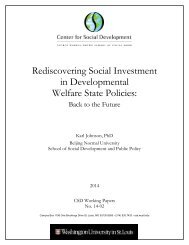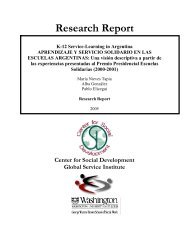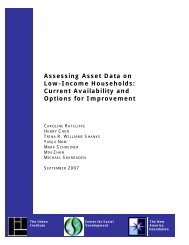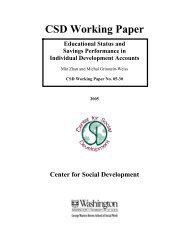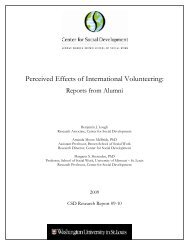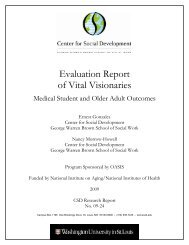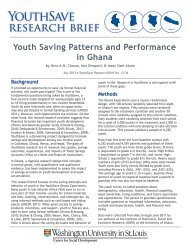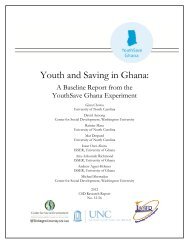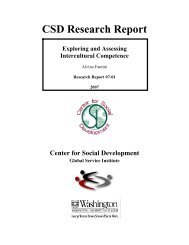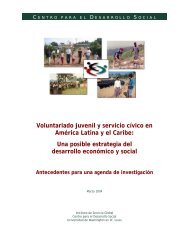institutional theory of saving - Center for Social Development ...
institutional theory of saving - Center for Social Development ...
institutional theory of saving - Center for Social Development ...
Create successful ePaper yourself
Turn your PDF publications into a flip-book with our unique Google optimized e-Paper software.
Overview <strong>of</strong> Institutional Savings Theory 1<br />
From an <strong>institutional</strong> perspective, <strong>saving</strong> and asset accumulations are in large part the result<br />
<strong>of</strong> structured mechanisms involving “explicit connections, rules, incentives, and subsidies”<br />
(Sherraden 1991, p. 116). For the non-poor, these mechanisms include deductions <strong>for</strong> home<br />
mortgage interest and property taxes, exclusions <strong>for</strong> employment-sponsored pension<br />
contributions and earnings, tax deferments <strong>for</strong> Individual Retirement Accounts (IRAs) and<br />
Keogh Plans, and employer contributions and tax deferments <strong>for</strong> employee pension plans.<br />
Low- and moderate-income households, with little existing <strong>saving</strong>s, do not have the same<br />
access to or receive the same incentives from institutions that promote and subsidize asset<br />
accumulation (Howard 1997; Seidman 2001; Sherraden 1991). For example, the poor are less<br />
likely to own homes, and when they do own homes, they receive little or no subsidy because<br />
they have low or zero marginal tax rates and the tax benefits are not refundable.<br />
We turn now to seven constructs that we believe are important aspects <strong>of</strong> institutions<br />
designed to promote <strong>saving</strong> and asset accumulation.<br />
Access<br />
Access refers to eligibility and practicality. Many U.S. households are not “eligible” <strong>for</strong><br />
programs and policies that encourage asset building—<strong>for</strong> example, a large portion <strong>of</strong> the<br />
population does not have access to a pension plan in the workplace—and eligibility varies<br />
substantially by race and class. Regarding practicality, distance is a major barrier to financial<br />
services and other markets in rural areas. The transaction costs involved in reaching these<br />
services can make them unavailable. In these circumstances, it is not fully in<strong>for</strong>mative to<br />
interpret <strong>saving</strong> and asset accumulation outcomes as resulting solely from individual<br />
characteristics and choices.<br />
1 Excerpted and adapted from “Determinants <strong>of</strong> Asset Holdings.” In M. Sherraden & S.-M. McKernan (Eds.),<br />
Asset Building and Low-Income Families (89-152). Washington, DC: Urban Institute Press.<br />
Campus Box 1196 One Brookings Drive St. Louis, MO 63130-9906 (314) 935.7433 www.gwbweb.wustl.edu/csd
In<strong>for</strong>mation<br />
Financial in<strong>for</strong>mation shapes <strong>saving</strong> and investment action. This in<strong>for</strong>mation may be general<br />
or specific to a particular financial product or program. For example, to participate<br />
successfully in a traditional IRA, a person must know that an IRA is available and that she is<br />
eligible. She must also know how to choose an appropriate investment, how to make<br />
contributions, how to receive the tax deduction, and, later, how to make withdrawals. Some<br />
individuals (probably those who are more educated and more com<strong>for</strong>table with financial<br />
matters) will seek out this type <strong>of</strong> in<strong>for</strong>mation, but many will not obtain in<strong>for</strong>mation unless it<br />
is delivered to them in an accessible <strong>for</strong>mat.<br />
Incentives and Disincentives<br />
We propose that financial incentives and disincentives shape <strong>saving</strong> and investment action.<br />
Incentives include subsidies and rates <strong>of</strong> return. 2<br />
Subsidies. Subsides are direct or indirect “payments” to those who save in particular <strong>saving</strong><br />
plans or hold particular kinds <strong>of</strong> wealth. Often these subsidies directly increase wealth, as in<br />
the case <strong>of</strong> matching contributions <strong>for</strong> deposits into 401(k)s and IDAs. Other times, these<br />
subsidies are not deposited into <strong>saving</strong> vehicles, so recipients may choose whether or not to<br />
save them. Matches increase the reward to <strong>saving</strong> and may help compensate <strong>for</strong> the sacrifice<br />
required to defer consumption. Matches may also motivate people to save by translating a<br />
given level <strong>of</strong> <strong>saving</strong> into a stock <strong>of</strong> wealth that is large enough to use <strong>for</strong> a major assets,<br />
such as a house or a college education. Finally, the match may be the program feature that<br />
catches a participant’s eye and motivates him to enroll in the first place. However, although<br />
incentives may cause people to save more by increasing the reward <strong>for</strong> <strong>saving</strong>, they may also<br />
encourage people to save less because match money allows them to reach a fixed <strong>saving</strong>s<br />
goal with less <strong>of</strong> their own <strong>saving</strong>. In addition, people may simply reshuffle assets, that is,<br />
move existing assets from another <strong>saving</strong>s vehicle into the match-eligible product instead <strong>of</strong><br />
<strong>saving</strong> more.<br />
Rates <strong>of</strong> return. Rates <strong>of</strong> return, <strong>of</strong>ten measured as interest, refer to the relationship between<br />
the amount <strong>of</strong> an investment and the pr<strong>of</strong>it or loss earned by that investment. That fact that<br />
investors seek the highest possible rate <strong>of</strong> return <strong>for</strong> a given level <strong>of</strong> risk provides some<br />
evidence that financial incentives shape financial decisions.<br />
Disincentives. Disincentives include unattractive or even negative rates <strong>of</strong> return. Other types<br />
<strong>of</strong> disincentives, such as means-tested income transfer programs like Temporary Assistance<br />
<strong>for</strong> Needy Families (TANF), Food Stamps, and Supplemental Security Income, reduce the<br />
2 Incentives may also include nonfinancial rewards, such as peer relationships, status, or opportunities to learn.<br />
We focus here on financial incentives because we suspect that, overall, financial incentives tend to be more<br />
important than non-financial incentives.<br />
<strong>Center</strong> <strong>for</strong> <strong>Social</strong> <strong>Development</strong> 2<br />
Washington University in St. Louis
need <strong>for</strong> or even the desirability <strong>of</strong> assets. Asset means tests are expected to discourage<br />
<strong>saving</strong> because households must spend down or keep their financial assets below asset limits<br />
in order to be eligible <strong>for</strong> program benefits.<br />
Facilitation<br />
Facilitation refers to any <strong>for</strong>m <strong>of</strong> assistance in <strong>saving</strong>, especially making <strong>saving</strong> “automatic.”<br />
Common examples are automatic payroll deduction and automatic transfers into <strong>saving</strong><br />
products. Another type <strong>of</strong> facilitation involves automatic enrollment into a <strong>saving</strong>s plan.<br />
Automatic enrollment is likely to shape <strong>saving</strong> and investment action because, as behavioral<br />
<strong>theory</strong> suggests, people <strong>of</strong>ten postpone financial decisions and remain with the status quo. A<br />
third and perhaps surprising source <strong>of</strong> facilitation is the federal income tax system. By<br />
providing sizeable refunds to many households (through the Earned Income Tax Credit and<br />
Child Tax Credit, <strong>for</strong> example), the income tax system may shape <strong>saving</strong> action.<br />
Expectations<br />
Expectations are implicit or explicit suggestions about desired <strong>saving</strong>, investment, or asset<br />
accumulation. They are embodied in <strong>institutional</strong> features such as match caps (amount <strong>of</strong><br />
money that earns matching deposits), <strong>saving</strong> targets, and social pressure <strong>of</strong> peers and staff <strong>of</strong><br />
<strong>saving</strong> programs. For example, the fact that up to $4,000 in contributions to a traditional<br />
IRA is tax deductible may set up an expectation that individuals save $4,000 a year <strong>for</strong><br />
retirement.<br />
Restrictions<br />
Restrictions are prohibitions, rules that restrict access to or use <strong>of</strong> assets. Most subsidized<br />
<strong>saving</strong> policies have restrictions. For example, money in 529 college <strong>saving</strong>s plans must be<br />
used <strong>for</strong> college education, and 401(k) <strong>saving</strong>s are not available until retirement. We<br />
hypothesize that restrictions shape <strong>saving</strong> action, specifically by helping people resist<br />
temptations to spend <strong>saving</strong>s.<br />
Security<br />
Security refers to freedom from unreasonable risk in <strong>saving</strong> and asset holding. All<br />
households need a safe place to put their money. We propose that security shapes <strong>saving</strong> and<br />
investment action, specifically that people are more likely to deposit, less likely to withdraw,<br />
and more likely to have a diverse portfolio when they can participate in a variety <strong>of</strong> secure<br />
<strong>saving</strong> policies, programs, and products. Where such access and trust cannot be taken <strong>for</strong><br />
granted, (lack <strong>of</strong>) security may be the dominant <strong>institutional</strong> construct in explaining <strong>saving</strong><br />
action and <strong>saving</strong>s outcomes. African Americans have much lower net worth than whites<br />
and hold smaller portions <strong>of</strong> their investments in financial securities and larger portions in<br />
real estate. As scholars ranging from W.E.B. Dubois (1935) to Melvin Oliver and Thomas<br />
<strong>Center</strong> <strong>for</strong> <strong>Social</strong> <strong>Development</strong> 3<br />
Washington University in St. Louis
Shapiro (1995) have noted, blacks historically have had reason not to trust financial<br />
institutions and security investments, preferring literally to keep their money closer to home.<br />
References<br />
Beverly, S., Sherraden, M., Cramer, R., Shanks, T. R. W., Nam, Y., & Zhan, M. (2008).<br />
Determinants <strong>of</strong> asset holdings. In S.-M. McKernan & M. Sherraden (Eds.), Asset<br />
building and low-income families (89-152). Washington, DC: Urban Institute.<br />
Dubois, W. E. B. (1935). Black reconstruction: An essay toward a history <strong>of</strong> the part which black folk<br />
played in the attempt to reconstruct democracy in America, 1860-1880. New York: Harcourt,<br />
Brace and Company.<br />
Howard, C. (1997). The hidden welfare state: Tax expenditures and social policy in the United States.<br />
Princeton, NJ: Princeton University Press.<br />
Seidman, L. (2001). Assets and the tax code. In T. M. Shapiro & E. N. Wolff (Eds.), Assets<br />
<strong>for</strong> the poor: The benefits <strong>of</strong> spreading asset ownership (324-56). New York: Russell Sage<br />
Foundation.<br />
Oliver, M. L., & Shapiro, T. M. (1995). Black wealth/white wealth: A new perspective on racial<br />
inequality. New York: Routledge.<br />
Sherraden, M. (1991). Assets and the poor. Armonk, NY: M.E. Sharpe.<br />
<strong>Center</strong> <strong>for</strong> <strong>Social</strong> <strong>Development</strong> 4<br />
Washington University in St. Louis



